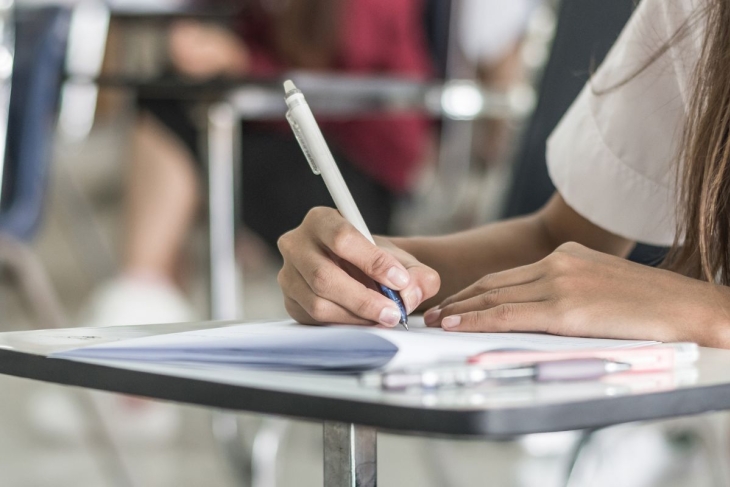A new report from the Hoover Institution’s Education Success Initiative provides another close look at the U.S. education system’s global standing in the aftermath of Covid, focusing specifically on the economic impacts the changes portend.
Analysts Eric Hanushek and Bradley Strauss compare Program for International Student Assessment (PISA) and the National Assessment of Educational Progress (NAEP) data from before and after pandemic-related school closures and the temporary shift to remote learning. They show where American students as a whole landed in the achievement distribution, how international standings changed pre- and post-Covid, and conduct an interesting state-by-state analysis.
Hanushek and Strauss start with the most-recent administration of PISA, which tested the math, reading, and science skills of fifteen-year-old students in eighty-one countries and territories in 2022. To reduce noise in the data, comparisons are pared down to math results only. The United States ranked thirty-fourth among all participants, slightly below the mean score of the combined Organization for Economic Co-operation and Development (OECD) countries and comparable to Malta and the Slovak Republic. We are three-quarters of a standard deviation behind Singapore, the top performer internationally, and half of a standard deviation behind Macao and Taiwan—numbers two and three. While Singapore, Taiwan, Saudi Arabia, and ten others actually showed a gain in PISA math results between 2018 (the last administration prior to Covid) and 2022, the United States was among the large cadre of countries that registered score drops: approximately 15 points. While not as steep as a number of others—Norway shed almost 35 points, Iceland nearly 40—Hanushek and Strauss calculate the economic impact of the drop on American students this way: The average student will have 5−6 percent lower lifetime earnings compared to expected earnings had there been no pandemic, unless something is done to fully remediate this learning loss. Absent such a fix, they calculate, the resulting lower-quality future labor force will cost the U.S. economy up to $31 trillion (in 2020 dollars)—equivalent to a 3 percent lower GDP throughout the remainder of the century.
2022 math results for NAEP, “The Nation’s Report Card,” are “transformed” by the analysts onto the same scale as PISA math results, creating a putative scale where individual states are ranked in comparison to PISA countries. The best-performing state on NAEP in 2022 was Massachusetts. It would be sixteenth in the world if it were ranked on its own, placing student performance just ahead of the average student in Austria and just behind the average student in the United Kingdom. The next-highest-performing state was Utah, ranking twenty-first between Slovenia and Finland. At the other end of the spectrum, thirteen states—including Oklahoma, West Virginia, Washington, D.C., and New Mexico—fell behind the average student performance in 77th-place Turkey.
Despite being the top state, Massachusetts was among those states registering more than a 10-point drop in NAEP math scores. Oklahoma, Pennsylvania, Delaware, and Minnesota also registered scores more than 10 points lower in 2022 than in 2018. Fordham’s home state of Ohio was in the middle, dropping between 5 and 7 points overall and finishing just above Norway and the OECD average in the putative international rankings.
“The full explanation of the causes of the differential losses is not available,” Hanushek and Strauss write, “but there is evidence that hybrid and remote instruction related to closures contributed to the distribution of losses.” This becomes more obvious when we consider the widely varying Covid responses from different U.S. states. They then calculate the heterogeneity of impacts on average lifetime earnings—using their previous PISA-based methodology—in each state, finding a 4 percent loss for students whose states were at the top of the score distribution (like Massachusetts and Utah) and a whopping 9 percent loss for those at the bottom (such as Delaware and Oklahoma).
The silver lining around all this bad news is that these losses are not completely irremediable. Improved curricula, high-quality teaching, extended school days, and high-dosage tutoring have all shown promise in helping students catch up and accelerate back to where data indicate they should be. Hanushek and Strauss cite all these and more in their report. Unfortunately, here in 2024 (and even in 2022 when these state and international data were collected), time has already run out for older students, and some level of learning and economic losses have already been cemented into their futures. How many more students will leave high school before we can say we’ve done everything we can to help?
SOURCE: Eric A. Hanushek and Bradley Strauss, “A Global Perspective on U.S. Learning Losses,” Hoover Education Success Initiative (February 2024).




